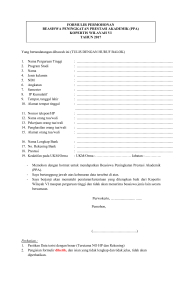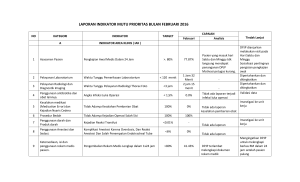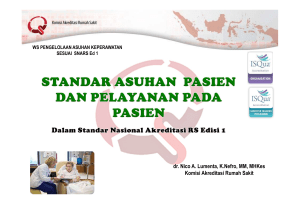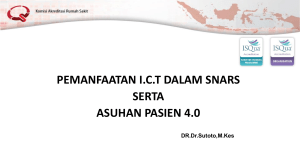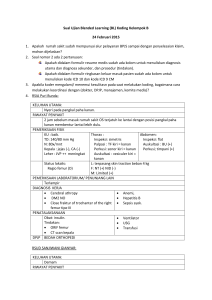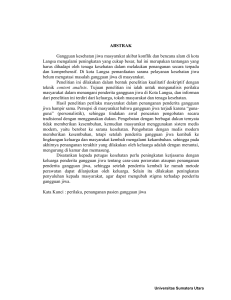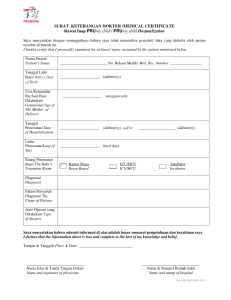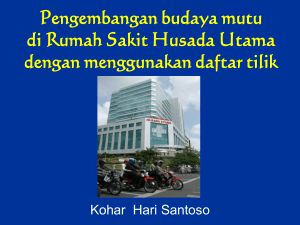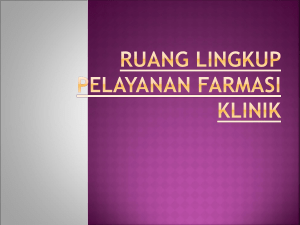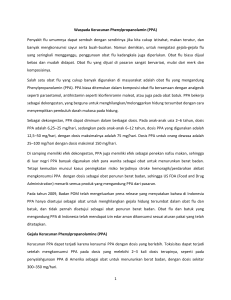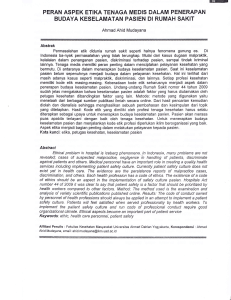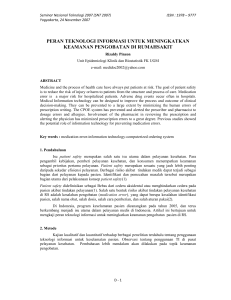dr Nico A.Lumenta, K.Nefro, MM, MHKes
advertisement
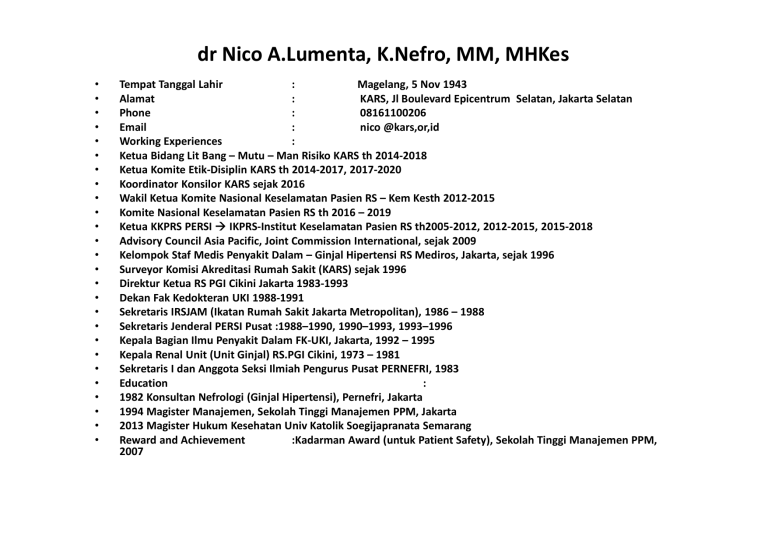
dr Nico A.Lumenta, K.Nefro, MM, MHKes • • • • • • • • • • • • • • • • • • • • • • • • • • Tempat Tanggal Lahir : Magelang, 5 Nov 1943 Alamat : KARS, Jl Boulevard Epicentrum Selatan, Jakarta Selatan Phone : 08161100206 Email : nico @kars,or,id Working Experiences : Ketua Bidang Lit Bang – Mutu – Man Risiko KARS th 2014-2018 Ketua Komite Etik-Disiplin KARS th 2014-2017, 2017-2020 Koordinator Konsilor KARS sejak 2016 Wakil Ketua Komite Nasional Keselamatan Pasien RS – Kem Kesth 2012-2015 Komite Nasional Keselamatan Pasien RS th 2016 – 2019 Ketua KKPRS PERSI IKPRS-Institut Keselamatan Pasien RS th2005-2012, 2012-2015, 2015-2018 Advisory Council Asia Pacific, Joint Commission International, sejak 2009 Kelompok Staf Medis Penyakit Dalam – Ginjal Hipertensi RS Mediros, Jakarta, sejak 1996 Surveyor Komisi Akreditasi Rumah Sakit (KARS) sejak 1996 Direktur Ketua RS PGI Cikini Jakarta 1983-1993 Dekan Fak Kedokteran UKI 1988-1991 Sekretaris IRSJAM (Ikatan Rumah Sakit Jakarta Metropolitan), 1986 – 1988 Sekretaris Jenderal PERSI Pusat :1988–1990, 1990–1993, 1993–1996 Kepala Bagian Ilmu Penyakit Dalam FK-UKI, Jakarta, 1992 – 1995 Kepala Renal Unit (Unit Ginjal) RS.PGI Cikini, 1973 – 1981 Sekretaris I dan Anggota Seksi Ilmiah Pengurus Pusat PERNEFRI, 1983 Education : 1982 Konsultan Nefrologi (Ginjal Hipertensi), Pernefri, Jakarta 1994 Magister Manajemen, Sekolah Tinggi Manajemen PPM, Jakarta 2013 Magister Hukum Kesehatan Univ Katolik Soegijapranata Semarang Reward and Achievement :Kadarman Award (untuk Patient Safety), Sekolah Tinggi Manajemen PPM, 2007 RAKERNAS PERSI XIII Palembang, 26-28 Juli 2017 dr. Nico A. Lumenta, K.Nefro, MM, MHKes Komisi Akreditasi Rumah Sakit Fakultas Kedokteran Univ Kristen Indonesia, 1970 Konsultan Nefrologi Perhimpunan Nefrologi Indonesia, 1982 Lahir : Magelang 5 Nov 1943 Magister Manajemen Sekolah Tinggi Manajemen PPM Jakarta, 1994 Magister Hukum Kesehatan Univ Katolik Soegijapranata Semarang, 2013 Powerpoint Templates Templates Page 3 Ketua Bidang Lit Bang – Mutu – Man Risiko KARS th 2014-2018 Ketua Komite Etik-Disiplin KARS th 2014-2017, 2017-2020 Koordinator Konsilor KARS sejak 2016 Komite Nasional Keselamatan Pasien RS – Kem Kes th 2012-2015, 2016 Ketua KKPRS PERSI IKPRS-Institut Keselamatan Pasien RS th 2005-2012, 2012-2015, 2015-2018 Advisory Council Asia Pacific, Joint Commission International, sejak 2009 Kelompok Staf Medis Penyakit Dalam – Ginjal Hipertensi RS Mediros, Jakarta, sejak 1996 Powerpoint Templates Templates Page 4 Surveyor Komisi Akreditasi Rumah Sakit (KARS) sejak 1995 Konsilor KARS sejak 2012. PJ SubPokja Model Akreditasi Baru, Pokja Penyempurnaan Akreditasi RS, DitJen Bina Yan Med, DepKes, 2010-2011 Direktur Medik RS PGI Cikini, 1981 – 1982 Direktur Ketua RS PGI Cikini Jakarta 1982-1993 Dekan Fak Kedokteran UKI 1988-1991 Sekretaris Jenderal PERSI Pusat 1988–1990, 1990–1993, 1993–1996 Sekretaris IRSJAM 1986 – 1988 Kepala Bagian Ilmu Penyakit Dalam FK-UKI, Jakarta, 1992 – 1995 Kepala Renal Unit (Unit Ginjal) RS.PGI Cikini, 1973 – 1981 Sekretaris I & Seksi Ilmiah Pengurus Pusat PERNEFRI, 1983 Ketua Komite Medik RS Mediros, 1995 - 2013 Powerpoint Templates Templates Page 5 • Personalized medicine sebagai aspek cure • Personalized medicine dalam aspek care : PCC • Beberapa Aspek Filosofi dan Dimensi Budaya Q-S Asuhan Pasien • Person Centered Care • WHO Conceptual Framework on PCC 2016-2026 • Asuhan Pasien Terintegrasi • Kendala & Kiat Personalized medicine : A form of medicine that uses information about a person’s genes, proteins, and environment to prevent, diagnose, and treat disease (NCI Dictionary,2017) Bila kita sakit, siapapun kita, maka pengobatan yang diberikan kpd pasien adalah yang terbaik atau dpl berdasarkan EBM, jadi sesungguhnya bukan spesifik utk kita sbg individu. Dgn perkembangan teknologi genomik maka pasien a.l. dgn melanoma, leukemia, Ca paru, payudara, otak diperiksa rutin utk diagnosis/profil molekular-nya shg DPJPnya dpt memilih/menerapkan pengobatan yg “tailor made” yg sangat meningkatkan harapan hidupnya, ini adalah personalized medicine, atau bbrp istilah lain precision medicine, genomics medicine. Walaupun : In many cases, the current standard of care may be the safest, most sensible option, but it’s also “one size fits all.” Sometimes that’s perfectly sufficient, but not always. It is in that “not always” category that personalized medicine is making the most headway (D.McMullan : What Is Personalized Medicine) We look to a future in which medicine will be predictive, preventive, preemptive and personalized (Musunuru,K et al : Personalized Cardiovascular Medicine: Where We Stand Now, and The Road Ahead, American College of Cardiology) Beberapa definisi (Paving the Way for Personalized Medicine, FDA, 2013) • “The use of new methods of molecular analysis to better manage a patient’s disease or predisposition to disease.” – Personalized Medicine Coalition • “Providing the right treatment to the right patient, at the right dose at the right time.” – European Union • “The tailoring of medical treatment to the individual characteristics of each patient.” – President’s Council of Advisors on Science and Technology • “Health care that is informed by each person’s unique clinical, genetic, and environmental information.” – American Medical Association • “A form of medicine that uses information about a person’s genes, proteins, and environment to prevent, diagnose, and treat disease.” – National Cancer Institute, NIH Beberapa contoh : • HLA-B*57:01 gene developing a hypersensitivity reaction when treated with abacavir • mutations of the BRCA1 and BRCA2 genes that have been implicated in familial breast cancers • 2005, Stephanie Haney lung cancer th/ erlotinib, tdk berhasil, lalu genetic testing, ALK (anaplastic lymphoma kinase) positive, ganti ke crizotinib • Researchers have discovered more than 1,800 disease genes since the Human Genome Project’s completion Personalized medicine dari aspek care… Berbagai aspek penting asuhan pasien dalam standar akreditasi rumah sakit versi 2012 adalah a.l. • dilakukan oleh banyak disiplin & sebagai tim, • Keperawatan adalah profesi “24/7”, • Aspek care dan cure • Keseragaman pelayanan • diperlukan kolaborasi interdisiplin, • identifikasi kebutuhan pelayanan pasien, • keterlibatan dan pemberdayaan pasien yang didukung oleh sistem pendukungnya, • kemandirian pasien, kualitas hidup, • termasuk reimbursemen yang sesuai dan memadai Konsep yg mendasari standar asuhan pasien yg memenuhi standar akreditasi RS adalah Patient/Person Centred Care dengan Asuhan Pasien Terintegrasi PCC sudah merupakan trend global dalam Asuhan Pasien • Pelayanan Berfokus pd Pasien /Patient Centered Care berada dalam kumpulan standar akreditasi RS, menuntun ke asuhan pasien yg bermutu dan aman • Istilah Patient Centered Care sudah mulai tdk mencukupi lagi, krn sesungguhnya pasien merupakan seorg individu / person yg selain sakit juga memiliki hal-hal lain spt kebiasaan, preferensi/pilihan, situasi keluarga, sosio-spiritual-kultural, keadaan wellness, yg harus dimasukkan dlm keputusan klinis. • Pasien umumnya ingin independen juga pasca ranap. Sebab itu pelayanan diberikan tidak sekedar kpd Pasien, melainkan harus lebih yaitu kpd Person. Pemberi pelayanan perlu memahami pasien sbg person : Knowing the patient as an individual. • Karenanya lebih tepat memakai istilah “Pelayanan Berfokus pada Person” (Person Centred Care) sejalan dgn strategi WHO People Centred and Integrated Health Services (PCIHS), 2015 • Patient Centred Care sekarang berevolusi menjadi Person Centred Care - PCC • Diperlukan juga pemahaman dan internalisasi konsep PCC dan • • Asuhan Pasien Terintegrasi, oleh Profesional Pemberi Asuhan, agar penerapannya dlm asuhan pasien dgn pola Tim Interdisiplin dan Kolaborasi Interprofesional sesuai standar akreditasi. Dalam dokumen Position Statement Australian College of Nursing (ACN) tentang Person Centred Care (Nov 2014) dinyatakan bhw : Person-centred care means: treating each person as an individual; protecting a person’s dignity; respecting a person’s rights and preferences; and developing a therapeutic relationship between the care provider and care recipient which is built on mutual trust and understanding. Penerapan PCC memerlukan perubahan paradigma dan budaya Profesional Pemberi Asuhan DPJP Perawat/ Bidan Apoteker Nurisionis Dietisien Psikologi Klinis Terapis Fisik Profesional Pemberi Asuhan : mereka yg secara langsung memberikan asuhan kpd pasien, a.l. dokter, perawat, bidan, ahli gizi, apoteker, psikolog klinis, penata anestesi, terapis fisik dsb PCC Clinical Team Leader Teknisi Medis Penata Anestesi Lainnya PPA Tugas Mandiri, Tugas Kolaboratif, Tugas Delegatif TataKelola Rumah Sakit dlm perspektif Std Akred 2012 PASIEN UU 44/2009 ttg RS, Peraturan Per UU an lainnya Quality & Safety Standar Manajemen PMKP, PPI, TKP, MFK, KPS, MKI Sasaran KP Sasaran MDG’s Asuhan Pasien / Patient Care Sistem Manajemen PCC Std Yan Fokus Pasien APK, HPK, AP, PP, PAB, MPO PPK Sistem Pelayanan Klinis Regulasi : • Kebijakan • Pedoman, • Panduan • SPO • Program Indikator : • Ind. Area Klinis • Ind Klinis • Ind SKP • Ind Upaya Manajemen Dokumen Implementasi Good Patient Care Tata Kelola Asuhan Pasien yang Baik Good Clinical Governance PASIEN Quality & Safety Sistem Pelayanan Klinis Asuhan Pasien / Patient Care Tata Kelola Klinis yang Baik Good Hospital Governance Tata Kelola RS yang Baik Sistem Manajemen • Good Clinical Governance • Good Hospital Governance & Ps 36 UU 44/2009 • Good Patient Care Std Akreditasi RS 2012 Manajemen Risiko RS Pelayanan Fokus Person (Person Centred Risiko Klinis Care) Etik 4 Fondasi PPA Asuhan pasien • • • • Asuhan Asuhan Asuhan Asuhan Medis Keperawatan Gizi Obat • Mutu Kebutuhan • Patient Pasien Safety EBM VBM (Nico A Lumenta & Adib A Yahya, 2012) “Safety is a fundamental principle of patient care and a critical component of Quality Management.” (World Alliance for Patient Safety, Forward Programme, WHO, 2004) • Evidence Based Medicine • Value Based Medicine Dokumen RS untuk penerapan Standar Akreditasi Sistem Manajemen STANDAR AKREDITASI RUMAH SAKIT v.2012 PERATURAN PERUNDANG-UNDANGAN (NASIONAL) STANDAR PROFESI STANDAR INTERNASIONAL : WHO, ISQUA, LAINNYA Rumah Sakit SDM – Budaya – Unik – Komplex Dokumen Regulasi di RS Kebijakan – Pedoman – Panduan – SPO – Program Dokumen Implementasi di RS Rekam Medis – Form – Dok bukti lainnya Penyusunan o Cermati Gamb Umum Bab o Cermati pernyataan Standar o Cermati Maksud & Tujuan Std o Cermati Elemen Penilaian Perubahan o Pahami Filosofi/Konteks Pencacatan o Check list proses konsisten o Pencatatan akurat, nama, ttd o Pencatatan terbaca o Wadah Integrasi-komunikasi o Perlindungan hukum Budaya Q-S Asuhan Pasien PCC 17 Sistem Pelayanan Klinis Outcome terbaik Pentingnya ‘Organization Diagnostic’ untuk menjadi “High Performance Organization” (HPO) (Kompas, 28 Mei 2016) 3 2 3 (People) (System) 1 1 (Structure) 1 Atlet >< Organisasi Fisik & Tehnik prima 1. System – Structure – People Strategi & Taktik utk memenangkan pertandingan 2. Strategy, Visi-Misi-Tujuan Mental 3. Culture & Leadership Berbagai Definisi Budaya • Culture : a way of thinking, behaving, or working that exists in a place or organization (Merriam Webster) • Budaya terbentuk dari elemen2 : kebijakan, prosedur, kondisi2 kerja, struktur untuk pembuatan keputusan dan tipe2 perilaku yang didukung. (The Just Culture Community, Outcome Engineering, 2009) Dalam Definisi Budaya, ada pembagian dalam aspek : Antropologi, Sosial dan Organisasi • “A pattern of shared basic assumptions that the group learned as it solved its problems of external adaptation and internal integration, that has worked well enough to be considered valid and, therefore, to be taught to new members as the correct way you perceive, think, and feel in relation to those problems.“ (Barnes, V, US Nuclear Regulatory Commission) • Budaya adalah suatu cara hidup yang berkembang, dan dimiliki bersama oleh sebuah kelompok orang, dan diwariskan dari generasi ke generasi. • Budaya terbentuk dari banyak unsur yang rumit, termasuk sistem agama dan politik, adat istiadat, bahasa, perkakas, pakaian, bangunan, dan karya seni. (Wikipedia Bahasa Indonesia) Dimensi Budaya Mutu dan Safety dalam Standar Akreditasi RS ASUHAN PASIEN SAFETY RISIKO MUTU (Nico Lumenta, 2015) ASUHAN PASIEN Good Patient Care Patient Centered Care Asuhan Pasien Terintegrasi PPA sebagai Tim, Kolaborasi Interprofesional + Kompetensinya Berpartner dgn Pasien DPJP sebagai Clinical Leader MDR - Multidisciplinary Round BPIS RISIKO RS institusi yg kompleks dan high risk : asuhan multi PPA, multi budaya, multi regulasi, legal, finance, SD Risk Register Matrix Grading FMEA Situational Awareness RCA Dimensi Budaya Quality dan Safety dalam Standar Akreditasi RS SAFETY • • • • • • • Just Culture Reporting Culture Learning Culture Informed Culture Flexible Culture Generative Culture (MaPSaF) 7 Standar KP, 6 SKP, 7 Langkah KPRS, 13 Program WHO-PS MUTU Good Corp Governance Leadership Good Clinical Governance Standarisasi Input-Proses-OutputOutcome Pengukuran Mutu PDCA (Nico Lumenta, 2015) ASUHAN PASIEN Good Patient Care Patient Centered Care Asuhan Pasien Terintegrasi PPA sebagai Tim, Kolaborasi Interprofesional + Kompetensinya Berpartner dgn Pasien DPJP sebagai Clinical Leader MDR - Multidisciplinary Round BPIS RISIKO RS institusi yg kompleks dan high risk : asuhan multi PPA, multi budaya, multi regulasi, legal, finance, SD Risk Register Matrix Grading FMEA Situational Awareness RCA SAFETY Just Culture Reporting Culture Learning Culture Informed Culture Flexible Culture Generative Culture (MaPSaF) 7 Standar KP 6 SKP 7 Langkah KPRS 13 Program WHO-PS MUTU Good Corp Governance Leadership Good Clinical Governance Standarisasi Input-ProsesOutput-Outcome Pengukuran Mutu PDCA The Just Culture Model (simplified) Human Error At-Risk Behavior Product of Our Current System Design and Behavioral Choices A Choice: Risk Believed Insignificant or Justified Manage through changes in: • • • • • • Choices Processes Procedures Training Design Environment Console Dukungan © 2012 Manage through: • Removing incentives • • for at-risk behaviors Creating incentives for healthy behaviors Increasing situational awareness Coach Pelatihan Reckless Behavior Conscious Disregard of Substantial and Unjustifiable Risk Manage through: • Remedial action • Punitive action Punish Sanksi Disiplin Konsep inti – human error Human Error – Tindakan yang kurang hati2; perbuatan ceroboh bukan seperti yang seharusnya dilakukan; slip (meleset), lapse (terlewat), mistake (kesalahan) > console/didukung > belajar Konsep inti – perilaku berisiko ‘at-risk’ Perilaku ‘at-risk’ –perilaku yang meningkatkan risiko dimana risiko tidak tampak atau secara keliru dipercaya sebagai dibenarkan Konsep inti - perilaku sembrono/ceroboh Perilaku ceroboh – pilihan perilaku yang secara terus menerus tidak diperhatikan sebagai mengandung risiko atau risiko yang tak dapat dibenarkan Marx, D : Building A Culture of Accountability, ISQua Conf 2015, Doha Cultural competence Is a set of congruent behaviors, attitudes, and policies that come together in a system, agency or among professionals and enable that system, agency or those professions to work effectively in cross-cultural situations. Is a developmental process that evolves over an extended period. Adalah suatu perangkat kesamaan perilaku, sikap dan bersama secara harmonis dlm suatu sistem, badan atau para profesi utk bekerja secara efektif dlm situasi yg lintas-budaya / ‘cross-cultural’ Suatu proses pertumbuhan yg berkembang melampaui suatu kerangka waktu yg lama (Collins Dictionary of Medicine © Robert M. Youngson 2004) Cultural competence Both individuals and organizations are at various levels of awareness, knowledge and skills along the cultural competence continuum Baik individu maupun organisasi berada pada berbagai tingkat kesadaran (awareness), pengetahuan dan ketrampilan dalam kelangsungan cultural competence Possession of the knowled ge and skills required to m anage cross cultural relationships effectively. Cultural incompetence in doctors and other medical staff can seriously prejudice clinical management. Pengetahuan dan ketrampilan dibutuhkan utk mengelola hubungan lintas budaya secara efektif. Ketiadaan cultural competence pada para dokter dan staf medis lainnya dapat membuat prasangka negatif thd kemampuan pengelolaan klinis. Patient-centered care: the key to cultural competence The Golden Rule (Epner, DE & Baile, WF : Patient-centered care: the key to cultural competence. Annals of Oncology, vol 23, supl 3, 2012) * In the final analysis, we should treat our patients as we would want others to treat us during periods of vulnerability and fear. * The key to cultural competence is patient centeredness built on respect, sensitivity, composure, partnership, honesty, astuteness, curiosity, and tolerance. All people really care about is being cared about * Dalam analisis final, kita harus mperlakukan pasien2 kita sebagaimana kita ingin diperlakukan oleh orang lain, selama periode yg penuh dgn krisis maupun ketakutan * Kunci menuju kompetensi kultural adalah patient centeredness (focus kpd pasien) yg dibangun atas respek (rasa hormat), sensitivitas, kesabaran, kemitraan, kejujuran, kecerdikan, rasa ingin tahu, dan toleransi. Semua orang benar2 peduli ttg asuhan Why is it important to be culturally competent? • • • • • • • Increased respect Increased creativity Decreased unwanted surprises Increased participation from cultural groups Increased trust and cooperation Overcome fear of mistakes and conflict Promotes inclusion and equality Copyright © 2014 by The University of Kansas Conceptual framework for integrated people-centred health services IPCHS 2014services 2016-2026, July 2015) (WHO global strategy on integrated people-centred health WHO global strategy on integrated peoplecentred health services: an overview IPCHS 2014services 2016-2026, July 2015) (WHO global strategy on integrated people-centred health IPCHS The interdependency of the five strategic directions to support people-centred and integrated health services 1 4 2 5 3 2014services 2016-2026, July 2015) (WHO global strategy on integrated people-centred health IPCHS WHO global strategy on integrated people-centred health services 2016-2026, July 2015 Rumah Sakit Strategic Goal 1 Empowering & Engaging People Berdayakan dan Libatkan Pasien-Keluarga Strategic Goal 2 Strenghtening Governance & Accountabilty Tingkatkan-Perkuat Kepemimpinan & Akuntablitas Strategic Goal 3 Reorienting the Model of Care Reorientasi Paradigma Asuhan PCC Strategic Goal 4 Coordinating Services Asuhan Pasien Terintegrasi Strategic Goal 5 Creating an Enabling Environment Ciptakan Lingkungan yg Memberdayakan/Kondusif 2014 Profesional Pemberi Asuhan DPJP Perawat/ Bidan Apoteker Nurisionis Dietisien Psikologi Klinis Terapis Fisik Profesional Pemberi Asuhan : mereka yg secara langsung memberikan asuhan kpd pasien, a.l. dokter, perawat, bidan, ahli gizi, apoteker, psikolog klinis, penata anestesi, terapis fisik dsb PCC Clinical Team Leader Teknisi Medis Penata Anestesi Lainnya PPA Tugas Mandiri, Tugas Kolaboratif, Tugas Delegatif RENUNGKAN PERBEDAAN : PPA DAN PASIEN PPA : Menjalani pendidikan bertahun2, kompeten, memiliki kewenangan Pelayanan pasien dijalankan dgn standar, rutin, homogen, serba jelas. Aktivitas individu PPA hanya 1 shift Pasien : Masuk RS seperti masuk “hutan”, relatif banyak yg tidak jelas, pengalaman baru…. Pasien tidak “pernah” melalui “pendidikan untuk menjadi pasien” !!! Relatif tidak punya kewenangan ikut ambil keputusan, harus ikut “kata” dokter… Ada rasa cemas, ngeri, bingung, takut. Di RS, hanya Pasien yg menjalani “3 shift” !! KARS “Hutan” PPA 1. Profesional Pemberi Asuhan • Tim Interdisiplin • Tugas Mandiri, Tugas Kolaboratif, Tugas Delegatif • Asesmen pasien dgn pola IAR • Kolaborasi dan Kompetensi Interprofesional • Kompetensi masing2 PPA memadai • Kontribusi profesinya yg setara dlm fungsi profesinya 2. DPJP sebagai Clinical Leader, sbg “motor” Integrasi asuhan pasien 3. Rekam Medis : CPPT – Catatan Perkembangan Pasien Terintegrasi 4. Asuhan dgn BPIS : Bila Pasien Itu Saya Model Tradisional Ahli Gizi Fisio terapis Apoteker Perawat • Dokter merupakan PUSAT / UNIT SENTRAL dalam Model Tradisional • • • • asuhan pasien Dokter = Captain of the ship “Medical Paternalism” “Disease centred care” , tetapi…..Patient safety tidak terjamin !! Pasien Keluarga Dokter Bidan Analis Radio grafer Barrier (Kohn LT, Corrigan JM, Donaldson MS, eds. To err is human: building a safer health system. Washington, D.C.: National Academy Press, 2000.) Laporan Institute of Medicine – IOM TO ERR IS HUMAN Building a Safer Health System “Wake-up Call” …….bagi dunia pelayanan kesehatan……. Patient-Centered Care IOM – Institute of Medicine Patient-centered care : “care that is respectful of and responsive to individual patient preferences, needs and values, and ensuring that patient values guide all clinical decisions.” ‘Patient-centered care’ : “asuhan yang menghormati dan responsif terhadap pilihan, kebutuhan dan nilai-nilai pribadi pasien. Serta memastikan bahwa nilai-nilai pasien menjadi panduan bagi semua keputusan klinis” (2001) Picker Institute : 1.Respect for patients‘ values, preferences and expressed needs 2.Coordination and integration of care 3.Information communication and education 4.Physical comfort 5.Emotional support and alleviation of fear and anxiety 6.Involvement of family and friends 7.Continuity of care and smooth transition 8.Access to Care 1. Hormati nilai2, pilihan dan kebutuhan yg diutarakan oleh pasien 2. Koordinasi dan integrasi asuhan 3. Informasi, komunikasi dan edukasi 4. Kenyamanan fisik 5. Dukungan emosional dan penurunan rasa takut & kecemasan 6. Keterlibatan keluarga & teman2 7. Asuhan yg berkelanjutan dan transisi yg lancar 8. Akses terhadap pelayanan. Konsep Person Centred Care (Std HPK) Konsep Inti Core Concept Perspektif Pasien Perspektif PPA •Conway,J et al: Partnering with Patients and Families To Design a Patient- and Family-Centered Health Care System, A Roadmap for the Future. Institute for Patient- and Family-Centered Care, 2006 •Standar Akreditasi RS v.2012, KARS •Nico Lumenta, Sintesis berbagai literatur, 2015 What are the Core Concepts of Patient Centered Care? 1. Dignity and Respect. Health care practitioners listen to and honor patient and family perspectives and choices. Patient and family knowledge, values, beliefs and cultural backgrounds are incorporated into the planning and delivery of care. 2. Information Sharing. Health care practitioners communicate and share complete and unbiased information with patients and families in ways that are affirming and useful. Patients and families receive timely, complete, and accurate information in order to effectively participate in care and decision-making. 3. Participation. Patients and families are encouraged and supported in participating in care and decision-making at the level they choose. 4. Collaboration. Patients and families are also included on an institution-wide basis. Health care leaders collaborate with patients and families in policy and program development, implementation, and evaluation; in health care facility design; and in professional education, as well as in the delivery of care. Conway,J et al: Partnering with Patients and Families To Design a Patient- and Family-Centered Health Care System, A Roadmap for the Future. Institute for Patient- and Family-Centered Care, 2010 Core Concepts of Pasien Patient Centered Care 1. Martabat dan Respek. Perspektif • Profesional Pemberi Asuhan mendengarkan, menghormati & menghargai pandangan serta pilihan pasien & keluarga. • Pengetahuan, nilai-nilai, kepercayaan, latar belakang kultural pasien & keluarga dimasukkan dlm perencanaan pelayanan dan pemberian pelayanan kesehatan 2. Berbagi informasi. • Profesional Pemberi Asuhan mengkomunikasikan dan berbagi informasi secara lengkap pasien & keluarga. • Pasien & keluarga menerima informasi tepat waktu, lengkap, dan akurat • Dgn 3 asesmen: metode, substansi/kebutuhan edukasi, konfirmasi 3. Partisipasi. • Pasien & keluarga didorong dan didukung utk berpartisipasi dlm asuhan, pengambilan keputusan & pilihan mereka 4. Kolaborasi / kerjasama. • Pimpinan pelayanan kesehatan bekerjasama dgn pasien & keluarga dalam pengembangan, implementasi dan evaluasi kebijakan dan program; Conway,J et al: Partnering with Patients and Families To Design a Patient- and Family-Centered Health Care System, A Roadmap for the Future. Institute for Patient- and Family-Centered Care, 2010 Perspektif Profesional Pemberi Asuhan Core Concepts of Patient Centered Care 1. Berpartner dengan Pasien • Keputusan klinis berdasarkan (juga) nilai-nilai pasien • BPIS : Bila Pasien Itu Saya • Komitmen 2. PPA merupakan Tim Interdisiplin dgn Kolaborasi Interprofesional • Profesional Pemberi Asuhan diposisikan mengelilingi pasien bekerja sebagai Tim dgn Kolaborasi Interprofesional • Tugas Mandiri, Kolaboratif, Delegatif • Kompetensi Profesi dan Kompetensi Kolaborasi Interprofesional yang memadai 3. DPJP adalah Clinical Leader. • DPJP menyusun kerangka asuhan, melakukan koordinasi, kolaborasi, sintesis, interpretasi, review dan mengintegrasikan asuhan pasien 4. Asuhan Pasien Terintegrasi • Asuhan pasien terintegrasi oleh PPA dgn DPJP sbg Clinical Leader (Nico Lumenta, Sintesis berbagai referensi, 2015) Person Centred Care Core Concept Dignity & Respect Information Sharing Participation Collaboration Profesional Pemberi Asuhan : mereka yg secara langsung memberikan asuhan kpd pasien, a.l. dokter, perawat, bidan, ahli gizi, apoteker, psikolog klinis, penata anestesi, terapis fisik dsb (Nico Lumenta, 2015) Konsep Person Centred Care (Std HPK) Konsep Inti Core Concept Perspektif Pasien Perspektif PPA •Conway,J et al: Partnering with Patients and Families To Design a Patient- and Family-Centered Health Care System, A Roadmap for the Future. Institute for Patient- and Family-Centered Care, 2006 •Standar Akreditasi RS v.2012, KARS •Nico Lumenta, Sintesis berbagai literatur, 2015 Asuhan Terintegrasi Integrasi Intra-Inter PPA (AP 4, MKI 5 & 6) Integrasi Inter Unit (PP 2, APK 2, MKI 5) Integrasi PPA-Pasien (HPK 2, 2.1, AP 4) Horizontal & Vertical Integration Asuhan Terintegrasi Integrasi Intra-Inter PPA (AP 4, MKI 5 & 6) Integrasi Inter Unit (PP 2, APK 2, MKI 5) Integrasi PPA-Pasien (HPK 2, 2.1, AP 4) Horizontal & Vertical Integration 1. 2. 3. 4. 5. 6. 7. 8. 9. DPJP sbg Clinical Leader PPA sbg Tim, Kolaborasi Interprofesional Keterlibatan & Pemberdayaan Pasien-Keluarga CPPT – Catatan Perkembangan Pasien Terintegrasi Kolaborasi Pendidikan Pasien Manajer Pelayanan Pasien / Case Manager Integrated Clinical Pathway Integrated Discharge Planning Asuhan Gizi terintegrasi Profesional Pemberi Asuhan DPJP Perawat/ Bidan Apoteker Nurisionis Dietisien Psikologi Klinis Terapis Fisik Profesional Pemberi Asuhan : mereka yg secara langsung memberikan asuhan kpd pasien, a.l. dokter, perawat, bidan, ahli gizi, apoteker, psikolog klinis, penata anestesi, terapis fisik dsb PCC Clinical Team Leader Teknisi Medis Penata Anestesi Lainnya PPA Tugas Mandiri, Tugas Kolaboratif, Tugas Delegatif Pelimpahan Wewenang Keperawatan UU no 38/2014 Tentang Keperawatan Pasal 32 (3) Pelimpahan wewenang secara delegatif untuk melakukan sesuatu tindakan medis diberikan oleh tenaga medis kepada Perawat dengan disertai Pelimpahan pelimpahan tanggung jawab. Delegatif : (4) Pelimpahan wewenang secara delegatif • Tugas & • Tangg-jwb sebagaimana dimaksud pada ayat (3) hanya dapat diberikan kepada Perawat profesi atau Perawat vokasi terlatih yang memiliki kompetensi yang diperlukan (5) Pelimpahan wewenang secara mandat diberikan oleh tenaga medis kepada Perawat untuk Pelimpahan melakukan sesuatu tindakan medis di bawah Mandat : pengawasan. • Tugas (saja) (6) Tanggung jawab atas tindakan medis pada pelimpahan wewenang mandat sebagaimana • Tangg-jwb dimaksud pada ayat (5) berada pada pemberi tetap pelimpahan wewenang. KARS Dr.Nico Lumenta Dari berbagai pengertian pelayanan terintegrasi, definisi dari WHO : • WHO (2008) : “The management and delivery of health services so that clients receive a continuum of preventive and curative services, according to their needs over time and across different levels of the health system.” (Integrated Health Services, Technical Brief No.1, WHO 2008) Provider integration : Integrated care is a concept bringing together inputs, delivery, management and organization of services related to diagnosis, treatment, care, rehabilitation and health promotion. Integration is a means to improve services in relation to access, quality, user satisfaction and efficiency. User Integration For the user, integration means health care that is seamless, smooth and easy to navigate. Users want a co ordinated service which minimizes both the number of stages in an appointment and the number of separate visits required to a health facility. They want health workers to be aware of their health as a whole (not just one clinical aspect) and for health workers from different levels of a system to communicate well. In short, clients want continuity of care. (Integrated Health Services, Technical Brief No.1, WHO 2008) Horizontal integration : Integration of Multidisciplinary/multifunctional teamwork Partnership between the patient / service users, the carer and the professionals. Vertical integration Integration of different levels of care like primary, secondary, and tertiary care Vertical integration of clinical departments (Integrated Health Services, Technical Brief No.1, WHO 2008) Pendahuluan… The team structure at the department level of the hospital. Horizontal integration (Axelsson,,R et al : Organizing integrated care in a university hospital: application of a conceptual framework Int J Integr Care. 2014) Asuhan Terintegrasi Integrasi Intra-Inter PPA (AP 4, MKI 5 & 6) Integrasi Inter Unit (PP 2, APK 2, MKI 5) Integrasi PPA-Pasien (HPK 2, 2.1, AP 4) Horizontal & Vertical Integration 1. 2. 3. 4. 5. 6. 7. 8. 9. DPJP sbg Clinical Leader PPA sbg Tim, Kolaborasi Interprofesional Keterlibatan & Pemberdayaan Pasien-Keluarga CPPT – Catatan Perkembangan Pasien Terintegrasi Kolaborasi Pendidikan Pasien Manajer Pelayanan Pasien / Case Manager Integrated Clinical Pathway Integrated Discharge Planning Asuhan Gizi terintegrasi 1. DPJP sbg Clinical Leader 2. PPA sbg Tim, Kolaborasi Interprofesional 3. Keterlibatan & Pemberdayaan PasienKeluarga 4. CPPT – Catatan Perkembangan Pasien Terintegrasi 5. Kolaborasi Pendidikan Pasien 6. Manajer Pelayanan Pasien / Case Manager 7. Integrated Clinical Pathway 8. Integrated Discharge Planning 9. Asuhan Gizi terintegrasi 1. DPJP sebagai Clinical Leader *Standar PP.2.1 Asuhan kpd pasien direncanakan &tertulis di rekam medis pasien. Elemen Penilaian PP. 2.1 1. 4. Asuhan untuk setiap pasien direncanakan oleh Dr penanggung jawab pelayanan (DPJP), perawat dan pemberi yan kes lain dalam waktu 24 jam sesudah pasien masuk rawat inap. Rencana asuhan pasien hrs individual dan berdasarkan data asesmen awal pasien. Rencana asuhan dicatat dalam rekam medis dalam bentuk kemajuan terukur pencapaian sasaran. Kemajuan ….. 6. 7. Rencana asuhan disediakan ….. Asuhan yg diberikan kpd setiap pasien dicatat.... 2. 3. 5. Rencana asuhan utk tiap pasien direview dan di verifikasi oleh DPJP dgn mencatat pada CPPT nya 5. The care planned for each patient is reviewed and verified by the responsible physician with a notation in the progress notes. 61 CPPT : CATATAN PERKEMBANGAN PASIEN TERINTEGRASI Kolaborasi PPA melalui CPPT Tgl, Jam Profesional Pemberi Asuhan Instruksi PPA HASIL ASESMEN PASIEN DAN PEMBERIAN PELAYANAN Termasuk Pasca Bedah (Tulis dengan format SOAP/ADIME, disertai Sasaran. Tulis (Instruksi ditulis Nama, beri Paraf pada akhir catatan) dgn rinci dan jelas) 2/2/2015 Jm 8.00 Perawat S : Nyeri akut lutut kiri sejak 1-2 jam O : skala nyeri VAS : 7 TD 165/90, N 115/m, Frek Nafas : 30/m A : Nyeri akut arthritis gout P : Mengatasi nyeri dalam 2 jam dgn target VAS <4 2/2/2015 Jm 8.30 Dokter S : Nyeri lutut kiri akut sejak pagi O : Lutut kiri agak merah, nyeri tekan, skala NRS 7-8, hangat pd palpasi. A : Gouty Arthritis - flare Genu Sinistra P : inj steroid xx mg , tab colchicine 2 X 0,6 mg/hari. Paraf … Dst…. REVIEW & VERIFIKASI DPJP (Tulis Nama, beri Paraf, Tgl, Jam) (DPJP harus membaca/merevi ew seluruh Rencana Asuhan) • Monitoring nyeri tiap 30’ • Lapor DPJP • Kolaborasi pemberian anti Paraf.. inlamasi & analgesic Catatan/Notasi (review)DPJP … … … … … … … … … … … … … … … … … … … … …+paraf DPJP *Lapor 2 jam lagi skala nyeri *Foto Ro Lutut hari ini bila nyeri mereda/toleransi cukup Paraf DPJP tiap lembar DPJP Gambaran kegiatan Clinical Leader, sbg “motor” integrasi asuhan 1. DPJP rutin ronde tiap pagi. DPJP membaca CPPT catatan semua PPA (24 jam), terkait asuhan & perkembangan pasien, pelaksanaan pelayanan. Baca juga dari form lain a.l. “Nurse’s note”, Form gizi, dll. 2. Melakukan review, interpretasi, sintesis dari rencana dan pelaksanaannya POLA KEGIATAN DPJP SEHARI-HARI Sebagai Clinical Leader 3. Menyusun skalaCPPT prioritas (Std AP 4.1.)& Verifikasi DPJP : Kolom Review 4.Memberi catatan / notasi CPPT (Std PP pd 2.1. EP 5) utk a.l. perhatian, koreksi, arahan, instruksi dsb sebagai wujud integrasi !! 5.Atau, bila pelaksanaan asuhan sudah sesuai rencana & sasaran, maka DPJP cukup memberi paraf (= verifikasi) pada setiap lembar CPPT, paraf di pojok kanan bawah tiap lembar CPPT !! 63 2. PPA sbg Tim Interdisiplin dgn Kolaborasi Interprofesional Kompetensi Berkolaborasi *Standar PP.2. Ada prosedur untuk mengintegrasikan dan mengkoordinasikan asuhan yg diberikan kpd setiap pasien. Elemen Penilaian PP.2 1. Rencana asuhan diintegrasikan dan dikoordinasikan di antara berbagai unit kerja & yan (lih.juga APK.2, EP 3) 2. Pemberian asuhan diintegrasikan dan dikoordinasikan di berbagai unit kerja & yan 3. Hasil atau kesimpulan rapat dari tim asuhan atau diskusi lain ttg kerjasama dicatat dalam rekam medis pasien. *Standar AP.4. Staf medis, keperawatan dan staf lain yg bertangg-jwb atas pelayanan pasien, bekerja sama dlm menganalisis dan mengintegrasikan asesmen pasien Elemen Penilaian AP.4 1. Data dan informasi asesmen pasien dianalisis dan diintegrasikan. 65 Profesional Pemberi Asuhan DPJP Perawat/ Bidan Apoteker Nurisionis Dietisien Psikologi Klinis Terapis Fisik Profesional Pemberi Asuhan : mereka yg secara langsung memberikan asuhan kpd pasien, a.l. dokter, perawat, bidan, ahli gizi, apoteker, psikolog klinis, penata anestesi, terapis fisik dsb PCC Clinical Team Leader Teknisi Medis Penata Anestesi Lainnya PPA Tugas Mandiri, Tugas Kolaboratif, Tugas Delegatif 1 ASESMEN PASIEN (Periksa Pasien) IAR Profesional Pemberi Asuhan ASUHAN PASIEN 2 PEMBERIANPELAYANAN / IMPLEMENTASIRENCANA MONITORING Proses Asuhan Pasien Patient Care 1 PPA : Dokter Perawat Bidan Apoteker Nutrisionis Dietisien Teknisi Medis (PenataAnestesi) Terapis Fisik Diagram IAR Asesmen Pasien Pencatatan: (Skrining, “Periksa Pasien”) 1. Informasi dikumpulkan : Anamnesa, pemeriksaan fisik, pemeriksaan diagnostik / lain, dsb I 2. Analisis informasi : A Menetapkan Diagnosis, Masalah, Risiko Untuk mengidentifikasi Kebutuhan Yan Pasien 3. Rencana Asuhan/Plan of Care : Merumuskan rencana dan sasaran terukur Untuk memenuhi Kebutuhan Yan Pasien 2 Pemberian Pelayanan Implementasi Rencana Intervensi, Monitoring R Asesmen Awal Asesmen Ulang SOAP Tenaga Gizi : ADIME (Assessment, Diagnosis, Intervention (+Goals), Monitoring, Evaluation) Asesmen Ulang Proses Asuhan Pasien 2 blok proses, oleh masing2 PPA 1. Asesmen Pasien “IAR” S 1. INFORMASI DIKUMPULKAN : anamnesa, pemeriksaan I O fisik, pemeriksaan diagnostic / lain, dsb Std AP 1 2. ANALISIS INFORMASI : menghasilkan kesimpulan a.l. Std APK 1, 1.1.1, Diagnosis, Masalah, Risiko A 1.1.2, 3, 4, AP 1.3, A untuk mengidentifikasi kebutuhan pelayanan pasien 1.3.1, 1.2. EP 4, 1.9, 1.11, 4.1, PP 7. P 3. RENCANA PELAYANAN / Plan of Care, untuk memenuhi kebutuhan pelayanan pasien Std PP 2 EP 1, PP R 2.1, 5, Std AP 2, PAB 5, 7, 7.4. 2. Implementasi Rencana Pemberian Pelayanan Intervensi, Monitoring Pemberian pelayanan/asuhan, pelaksanaan rencana, beserta monitoringnya Std PP 2, EP 2, PP 5 EP 2 & 3, PAB 3 EP 5, 5.3, 6, 7.3, 69 Interprofessionality Interprofessional Collaboration (IPC) When multiple health workers from different professional backgrounds work together with patients, families, carers, and communities to deliver the highest quality of care Interprofessional Education (IPE) When students from two or more professions learn about, from and with each other to enable effective collaboration and improve health outcomes (FrameworkKARS for Action onLumenta Interprofessional Education & Collaborative Practice, WHO, 2010) Dr.Nico PPA : Kompetensi Kolaborasi Interprofesional Interprofessional Collaborative Practice Competency Domains Interprofessional Education Collaborative Expert Panel.. Core competencies for interprofessional collaborative practice: Report of an expert panel. Washington, D.C.: Interprofessional Education Collaborative, (2011) Kompetensi dalam Kolaborasi Interprofesional (38) Ranah Kompetensi 1: Values/Ethics for Interprofessional Practice (10) Bekerja bersama PPA lain untuk memelihara iklim saling respek (menghormati) dan berbagi nilai2. Ranah Kompetensi 2: Roles/Responsibilities (9) Menggunakan pengetahuan dari peran masing2 guna memperoleh dan mengatasi kebutuhan layanan kesehatan dari pasien dan populasi yang dilayani. Ranah Kompetensi 3: Interprofessional Communication (8) Berkomunikasi dengan pasien, keluarga, komunitas, dan PPA lain dengan cara yang responsif dan bertanggung jawab yang mendukung suatu pendekatan tim dalam pemeliharaan kesehatan serta pengobatan penyakit. Ranah Kompetensi 4: Teams and Teamwork (11) Menerapkan nilai2 membangun-relasi dan prinsip2 dinamika tim untuk kinerja efektif dalam tim dgn peran yang berbeda untuk merencanakan dan memberikan asuhan berfokus pasien-/populasi yang aman, tepat waktu, efisien, dan wajar. Interprofessional Education Collaborative Expert Panel.. Core competencies for interprofessional collaborative practice: Report of an expert panel. Washington, D.C.: Interprofessional Education Collaborative, (2011) PPA sebagai Tim Interdisiplin (Febr 2015 17 pages) What Are Multidisciplinary Rounds? - MDR MDR are a patient-centered model of care, emphasizing safety and efficiency, that enable all members of the team caring for patients to offer individual expertise and contribute to patient care in a concerted fashion MDR adalah asuhan model patient-centered, menekankan safety dan efisiensi, yang memberdayakan semua anggota tim asuhan pasien untuk memberikan keahlian individunya dan menambahkan asuhan pasien dalam gaya/pola yang disepakati With MDR, disciplines come together, informed by their clinical expertise, to coordinate patient care, determine care priorities, establish daily goals, and plan for potential transfer or discharge. Dengan MDR, para PPA berkumpul, melalui keahlian mereka, mengkoordinasikan asuhan pasien, menetapkan prioritas asuhan, menetapkan sasaran/goal harian, dan merencanakan pemindahan atau pemulangan (How to Guide : Multidisciplinary Rounds. Institute for Healthcare Improvement, updated February 2015 ) Why Is It Important to Conduct Multidisciplinary Rounds? Effective MDR can be a powerful vehicle for: o Coordinating care among disciplines o Reviewing current patient status o Clarifying patient goals and outcomes o Creating a comprehensive plan of care MDR yang efektif dapat menjadi wahana yang kuat bagi : o Koordinasi asuhan antar disiplin o Penelaahan status pasien terkini o Menjelaskan goal dan outcome pasien o Menciptakan suatu perencanaan asuhan yang komprehensif MDR provide a formal mechanism for daily communication among the care team, patients, and families regarding: o Identification of safety risks o Identification of daily goals MDR menjadi mekanisme formal bagi komunikasi harian antar tim asuhan, pasien, dan keluarga berkenaan dengan : o Identifikasi risiko safety o Identifikasi sasaran/goal harian (How to Guide : Multidisciplinary Rounds. Institute for Healthcare Improvement, updated February 2015 ) Why Is It Important to Conduct Multidisciplinary Rounds? MDR facilitate protocol or guideline use and understanding among the care team, providing: o A consistent approach o Education and teaching opportunities MDR memfasilitasi penggunaan protokol atau guideline / pedoman dan pemahaman antara tim asuhan, dalam memberikan o Suatu pendekatan yang konsisten o Kesempatan edukasi dan pembelajaran • MDR provide consistency for process improvement • MDR merupakan sarana peningkatan proses yang konsisten (How to Guide : Multidisciplinary Rounds. Institute for Healthcare Improvement, updated February 2015 ) 3. Keterlibatan Pasien – Keluarga Patient & Family Engagement KARS Dr.Nico Lumenta Patient Activation Measurement Pasien Pasif Pasrah KARS Dr.Nico Lumenta KARS Dr.Nico Lumenta KARS Dr.Nico Lumenta 6. Manajer Pelayanan Pasien Case Manager CASE MANAGER / MANAJER PELAYANAN PASIEN DPJP Perawat Clinical Leader : • Kerangka pokok asuhan • Koordinasi • Kolaborasi • Sintesis • Interpretasi • Review • Integrasi asuhan Fisio terapis Apoteker Pasien, Keluarga Radio grafer Ahli Gizi Analis Lainnya Yan Kes / RS Lain Yan Keuangan/ Billing MPP Case Manager Asuransi Perusahaan/ Employer BPJS Dokter Keluarga Output CM : Kontinuitas Pelayanan Pelayanan dgn Kendali Mutu dan Biaya Pelayanan yg memenuhi kebutuhan Pasien-Kel pd ranap s/d dirumah Good Patient Care Pasien Keluarga • Pembayar • Perusahaan • Asuransi Case Manager MPP (Laison, Penghubung,“Jemb atan”) • • • • • RS PPA Rohaniwan Unit2 Keuangan Case Management Concept Pembayar PPA Sistem Pendukung Keluarga,Teman, Tetangga dsb Pasien MPP/ Case Mgr • Penerapan PCC > • Kolaborasi PPA > • Kendali mutu asuhan • Kendali biaya asuhan • Kendali safety asuhan • Asuhan sesuai kebutuhan pasien • Kesinambungan pelayanan • Pasien memahami asuhan • QOL • Kepuasan pasien • Kemampuan pasien mengambil keputusan > • Keterlibatan & pemberdayaan > • Kepatuhan > • Kemandirian pasien • Optimalisasi sistem pendukung pasien • Pemulangan aman 7. Integrated Clinical Pathway UU no 29/2004 Praktik Kedokteran Pasal 44 Pasal 50 & 51 Standar Pelayanan Kedokteran Standar Profesi Standar Prosedur Operasional Permenkes 1438/2010 Standar Pelayanan Kedokteran Prinsip dasar : Std Pelayanan Kedokteran terdiri dari Pedoman Nasional Pelayanan Kedokteran - PNPK dan SPO PNPK (Pedoman Nasional Pelayanan Kedokteran) Terutama untuk penyakit yang banyak, mahal, risiko, bervariasi dalam praktik Dibuat oleh pakar multidisiplin Ideal, terkini, evidence-based, canggih Dikoordinasi Kemenkes, disahkan Menkes Literatur: Artikel asli Meta-analisis PNPK (asing) Buku ajar, etc Panduan profesi, Direktorat, Kesepakatan staf medis Diterjemahkan ke fasyankes menjadi: Standar Prosedur Operasional = PPK Sesuai dengan Jenis dan strata (hospital specific) (Sudigdo Sastroasmoro, Konsorsium Upaya Kesehatan, Ditjen BUK - Kemenkes RI, 2015) Dapat + Pathways Algoritme Protokol Prosedur Standing orders Dapat dilakukan tanpa menunggu PNPK 267 hal PANDUAN PRAKTIK KLINIS PPK Apendisitis Akut PPK Benign Prostat Hyperplasia PPK Fraktur Terbuka PPK Hernia Inguinalis PPK Total Knee Arthroplasty/Replacement PPK Demam Tifoid PPK Diare Akut PPK Kejang Demam PPK DHF PPK Pneumonia PPK Stroke Hemoragik PPK Stroke Iskemik PPK Perdarahan Subarachnoid PPK Placenta Previa Pada Kehamilan Aterm PANDUAN ASUHAN KEPERAWATAN PAK Apendisitis Akut PAK Benign Prostat Hyperplasia PAK Fraktur Long Bone PAK Total Knee Replacement PAK Diare Akut PAK Kejang Demam Sederhana PAK Placenta Previa Totalis PANDUAN ASUHAN GIZI PAG Apendisitis PAG Demam Tifoid PAG Diare Akut PAG Kejang Demam PAG Demam Berdarah PAG Bronkopneumonia PAG Stroke PAG Placenta Previa Totalis PANDUAN ASUHAN KEFARMASIAN PAKf Terkait Permasalahan pd Apendisitis PAKf Terkait Permasalahan Inguinalis PAKf Terkait Permasalahan PAKf Terkait Permasalahan PAKf Terkait Permasalahan Demam PAKf Terkait Permasalahan Obat / Drug Related Problem Obat / DRP pd Hernia Obat / DRP pd Demam Tifoid Obat / DRP pd Diare Obat / DRP pd Kejang Obat / DRP pd DBD Prinsip Penyusunan Clinical Pathway / Alur Klinis PPK + Algoritme, Protokol, Prosedur, Standing orders + Panduan Asuhan Keperawatan, Panduan Asuhan Gizi, Panduan Asuhan Kefarmasian, Panduan Asuhan PPA lainnya *Asuhan Pasien Terintegrasi* 97 (TIM PERSI PENYUSUN CLINICAL PATHWAY GUIDELINE , DES 2015) MENETAPKAN PRIORITAS CP YANG AKAN DIBUAT 1. HIGH VOLUME (BERDASARKAN DATA TAHUN YANG LALU) 2. HIGH VARIATION 3. HIGH COST 4. KASUS KOMPLEX 8. Integrated Discharge Planning Discharge Planning (Std APK 3 EP 3, AP 1.11) Transisi & Kontinuitas Yan Keluarga : Asuhan Dirumah Pra Admisi : o eLOS o Rujukan Discharge Planning • Awal & durante ranap • Kriteria • Tim Multidisiplin • Keterlibatan Pasien-Kel • Antisipasi masalah • Program Edukasi /Pelatihan Rawat inap Dirumah Edukasi, Pelatihan spesifik : Pasien-Kel Follow-up • Ke RS • Telpon Proses Pulang : o 24-48 jam pra-pulang o Penyiapan Yan dilingkungan o Kriteria pulang + o Resume pasien pulang o Transport o dsb Discharge Planning • Cegah Komplikasi Pasca Discharge • Cegah Readmisi Yan Kes Primer dilingkungan Yan Sosial Yan Penunjang, Rehab Standards for integrated discharge planning Standard 1: Communication and consultation Appropriate and effective mechanisms shall be in place for communication and consultation on matters relating to integrated discharge planning, with key stakeholders within and outside the organisation. Standard 2: Organisational structure and accountability Responsibility for integrated discharge planning shall be clearly defined and there shall be clear lines of accountability throughout the organization. Standard 3: Management and key personnel Appropriately qualified key personnel shall be in place to ensure that the integrated discharge planning service is provided safely, efficiently and cost-effectively. Standard 4: Education and training Education and Training in relevant aspects of integrated discharge planning shall be provided to all new and existing staff members (both permanent and temporary). (Code of Practice for Integrated Discharge Planning, Health Service Executive, 2008) Standard 5: Operational policies and procedures Written policies, procedures and guidelines for the integrated discharge planning process shall be based on the Health Service Executive Recommended Practices for Integrated Discharge Planning (Part 3), shall be available, implemented and shall reflect relevant legislation and published professional guidance. Standard 6: Integrated discharge planning process Integrated discharge planning shall include the patient and as appropriate, the family/carer in the development and implementation of the patient’s discharge plan and shall ensure that steps are taken to address necessary linkages with other healthcare providers in order to ensure a seamless transition from one stage of care to the next. Standard 7: Audit and monitoring Audits shall be carried out to ensure that the procedures for integrated discharge planning con- form to the required Standards and that the processes undertaken conform to the procedures. The audit results shall be used to identify opportunities for improvement (Code of Practice for Integrated Discharge Planning, Health Service Executive, 2008) PASIEN Pasien Quality & Safety Profesional Pemberi Asuhan Sistem Pelayanan Klinis Asuhan Pasien / Patient Care Manajemen Sistem Manajemen KODEKI Pasal 18 Setiap Dr memperlakukan teman sejawatnya sebagaimana ia sendiri ingin diperlakukan Perawat Fisio terapis Dokter Apoteker “BPIS” Pasien Radio grafer Analis Ahli Gizi Lainnya “Enthusiatic Patient” “Kepuasan Pasien” Pasien KARS Dr.Nico Lumenta Barrier to Patient Centered Care : Pasien • Sikap yang pasif • Kurang percaya diri bertanya • Tidak cukup pengetahuan utk analisis informasi • Status social-ekonomi • Cara pandang dan budaya yang keliru Dokter/Staf • Kurangnya pengetahuan, pelatihan ttg PCC • Kurang waktu, impractical (cara pikir yang berbelit) • Kurang motivasi • Kurang dihargai • Tidak terlatih menangkap ekspresi pasien ttg nilai, ide, perasaan • Sulit diimplementasi, tidak jelas akan adanya perbaikan outcome Rumah Sakit • RS yang enggan melakukan perubahan • Kurangnya sumber daya • • Dunn,N : Practical Issues Around Putting The Patient in Centre of Care, J R Soc Med. Jul 2003 Bensberg, M :Patient Centred Care Literatur Review, Dandenong District Division of General Practice, October 2007 Promoting Patient-centered Care Beberapa elemen pokok untuk keberhasilan RS menerapkan / melaksanakan asuhan berfokus pasien / PCC adalah : 1. Komitmen kuat senior leadership 2. Komunikasi yang jelas tentang visi strategis, 3. Keikutsertaan aktif dengan pasien dan keluarga di seluruh RS, 4. Fokus terhadap kepuasan staf, 5. Penilaian dan umpan balik secara aktif dalam pelaporan pengalaman pasien, 6. Sumber yg adekuat untuk redesain pemberian asuhan, 7. Capacity building staf, 8. Akuntabilitas dan insentif 9. Budaya yang kuat mendukung perubahan dan pembelajaran. (Luxford,K., Safran,DG., Delbanco,T . Promoting patient-centered care: a qualitative study of facilitators and barriers in healthcare organizations with a reputation for improving the patient experience. Journal for Quality in Health Care, vol 23, 2011) • • • • • Pada aspek Cure personalized medicine melalui pemeriksaan profil molekular-nya dapat diterapkan pengobatan yg “tailor made” yg sangat meningkatkan harapan hidup pasien Pada aspek Care personalized medicine adalah Patient Centred Care yang telah berevolusi menjadi Person Centred Care Pemberi pelayanan tidak hanya melayani pasien tetapi harus mengenal pasien tsb sbg individu yg utuh / person : Knowing the patient as an individual. Seorang individu umumnya ingin independen, memiliki hal-hal lain spt kebiasaan, preferensi/pilihan, situasi keluarga, sosiospiritual-kultural, keadaan wellness, yg harus dimasukkan dlm keputusan klinis. Pasien sebagai person adalah pusat dalam proses asuhan pasien Person Centered Care – PCC • • Konsep inti PCC : A. Sisi Pasien : Martabat & Respek, Informasi, Partisipasi, Kolaborasi B. Sisi PPA : Berpartner dgn Pasien, PPA adalah Tim Interdisiplin, DPJP adalah Clinical Leader, Asuhan Pasien Terintegrasi Penerapan PCC dilaksanakan melalui Asuhan Pasien Terintegrasi dengan : Integrasi Intra-Inter PPA Integrasi Inter Unit Integrasi PPA-Pasien Dalam elemen2 : DPJP sbg Clinical Leader, PPA sbg Tim yg berkolaborasi interprofesional, Keterlibatan & Pemberdayaan Pasien-Keluarga, CPPT – Catatan Perkembangan Pasien Terintegrasi, Kolaborasi Pendidikan Pasien, Manajer Pelayanan Pasien / Case Manager, Integrated Clinical Pathway, Integrated Discharge Planning, Asuhan Gizi terintegrasi Terima kasih dr. Nico A. Lumenta, K.Nefro, MM, MHKes Komisi Akreditasi Rumah Sakit
